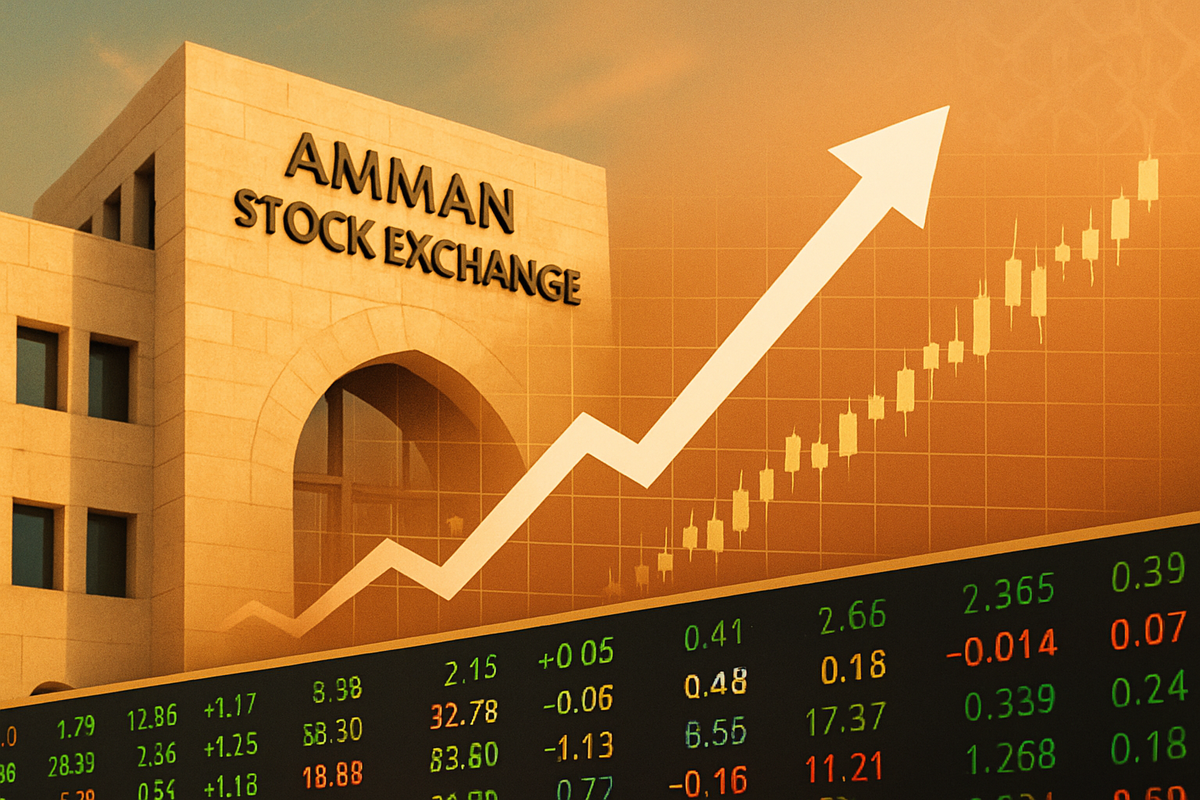
Amman, Jordan – October 4, 2025 – The Amman Stock Exchange (ASE) General Index has demonstrated a remarkable resurgence, surpassing the 3,000-point mark for the first time since 2008. This significant upturn reflects a robust and fundamentally driven market recovery, signaling renewed investor confidence in Jordan's resilient economy and strategic government reforms. As of October 4, 2025, the index closed the week at 3,038 points, a testament to a sustained climb of over 500 points since the beginning of the year and a year-to-date increase of approximately 21.7 percent. This performance has positioned the Jordanian financial market for a pivotal period of growth and stability.
The rally is not merely a fleeting surge but a reflection of deep-seated improvements, including strong corporate earnings, enhanced macroeconomic indicators, and proactive government policies. This positive momentum is drawing both domestic and international attention, indicating a potential shift in Jordan's standing as a regional investment hub.
Detailed Market Performance and Catalysts
The ASE General Index's journey past the 3,000-point threshold on September 13, 2025, marked a psychological and technical milestone, demonstrating its strongest performance in over a decade. This upward trend was also mirrored in the market capitalization, which rose by 26.31% between the end of 2024 and July 2025, reaching JD22.3 billion—its highest value since 2010. Average daily trading volumes surged by 83.15% to JD7.58 million, indicating increased liquidity and investor activity. The industrial sector, particularly companies in phosphate and potash, was a primary driver of this growth, reporting record results, with the financial sector also contributing significantly. Overall, 96 listed firms saw their share prices increase since the start of 2025.
The groundwork for this rally was meticulously laid over the preceding months and years. Towards the end of 2023, the ASE General Index (ASEGI) closed at 2431.2 points, setting a high benchmark. Jordan's economy showed resilience with a 2.3% year-on-year growth in 2024, followed by a 2.7% expansion in Q1 2025, notably driven by manufacturing and agriculture. By the first half of 2025, listed companies reported a collective increase of over 9% in their net profits. Mid-September 2025 saw non-Jordanian holdings in the ASE reach JD26.4 billion, underscoring significant foreign participation.
Several key players and stakeholders have been instrumental in this market upswing. The Amman Stock Exchange (ASE), led by CEO Mazen Wathaifi, has focused on enhancing market activity and integrity. The Jordan Securities Commission (JSC), as the primary regulator, has ensured transparency and compliance. The Jordanian Government, through its Economic Modernization Vision and numerous stimulus measures, including tax exemptions for mutual funds, reduced brokerage fees, and extended trading hours, has fostered an attractive investment climate. Minister of State for Economic Affairs, Muhannad Shehadeh, has championed these reforms. Leading listed companies, particularly industrial giants like Jordan Phosphate Mines Company (ASE: JOPH) and Arab Potash Company (ASE: ARPT), along with financial institutions like Arab Bank Group (ASE: ARBK), have directly contributed through strong earnings. Both domestic and a growing base of foreign investors, including significant participation from Gulf countries, India, and China, have injected crucial liquidity. The Central Bank of Jordan (CBJ), by mirroring the US Federal Reserve's interest rate cut, aimed to stimulate local borrowing and investment. Initial market reactions have been largely positive, viewing the rise as a reflection of Jordan's economic resilience, though some analysts noted that gains were concentrated in a few dominant players.
Companies Poised for Gains and Potential Underperformers
The ASE General Index tracks the performance of the 100 most liquid and largest companies, representing approximately 90% of the aggregate market capitalization. A rising index generally signals a growing economy, boosting investor confidence and leading to increased consumer spending, which in turn benefits businesses through higher revenues and market valuations.
Companies and Sectors Likely to Win:
The Financial Sector, constituting roughly half of the ASE's market value, is a primary beneficiary. A healthy economic environment directly benefits financial institutions through increased lending, improved asset quality, and higher profitability. Key players like Arab Bank Group (ASE: ARBK), the largest listed company by market capitalization, is poised for enhanced valuation and profitability. The Housing Bank for Trade and Finance (ASE: THBK) and Jordan Kuwait Bank (ASE: JKBK) are also well-positioned to capitalize on the positive market sentiment. Capital Bank (ASE: CABL) has seen significant profit surges due to acquisitions, making it a strong contender.
The Industrial Sector (Mining, Chemical Industries, Pharmaceutical and Medical Industries, Food and Beverages) also benefits significantly from increased demand and economic activity. Jordan Phosphate Mines Company (ASE: JOPH) and Arab Potash Company (ASE: ARPT), powerhouses in the mining sector, benefit from increased global demand for exports. The Jordan Petroleum Refinery Company (ASE: JPRC) is also expected to see increased activity. Pharmaceutical companies like Hayat Pharmaceutical Industries Co. (ASE: HPHI) and Philadelphia Pharmaceuticals (ASE: PHPC) tend to perform consistently, benefiting from overall market buoyancy.
The Services Sector (Telecommunications, Commercial Services, Educational Services, Hotels and Tourism, Transportation) benefits from increased consumer spending and business expansion. Zain Jordan (ASE: ZAIN), a key player in telecom, is well-positioned with its investments in 5G and digital services. Royal Jordanian Airlines (ASE: RJAL) and Jordan Telecommunications Company (ASE: JTEL) would also benefit from increased travel and connectivity demands.
Companies and Sectors That Might Underperform or Be Less Affected:
Companies not included in the index or with low liquidity might not see the same direct benefit from index-tracking investments. Companies with high debt or weak fundamentals might struggle to capitalize on the improved economic environment, as a rising market can sometimes mask underlying weaknesses. Sectors highly sensitive to specific external shocks or policy changes, such as utilities (due to regulations and commodity prices) or those with high input costs amidst inflation, could see profit margins squeezed. Companies affected by specific local challenges, such as inefficient bureaucracy, high electricity costs, or recurrent regulatory changes, might find it harder to fully leverage a positive market trend.
Wider Significance and Regional Context
The surge in the ASE General Index in 2025 is deeply embedded within Jordan's broader economic modernization and reflects a significant vote of confidence in the nation's stability and reform agenda. This rise aligns with the government's comprehensive 10-year Economic Modernization Vision (EMV) (2023-2035), which aims to double GDP growth and stimulate job creation through private and foreign direct investment. Robust economic indicators, including projected GDP growth between 2.3% and 2.9% for 2025, a 2.7% GDP growth in Q1 2025, and a significant surge in Foreign Direct Investment (FDI) by 36.4% in H1 2025, underscore the market's fundamental strength. Foreign investment in the ASE itself has surged by 32% since January 2025, with non-Jordanian holdings exceeding JD26.38 billion, largely from GCC countries, India, and China.
The ASE's robust performance has several ripple effects. It enhances investor confidence in Jordan's economic stability, making it a more attractive destination for capital, potentially drawing capital that might otherwise be allocated to regional competitors. The thriving industrial and financial sectors are direct beneficiaries, seeing increased valuations and profits. Improved market liquidity and trading volumes have also positively impacted brokerage firms. The government's proactive regulatory and policy changes, including pro-investment reforms, stimulus packages, new financial consumer protection instructions, and a focus on green finance development, have been crucial.
Historically, the current rally is particularly noteworthy. The ASE General Index surpassing the 3,000-point mark and market capitalization reaching JD23.6 billion are highs not seen since 2008 and 2010, respectively, demonstrating a significant recovery after a prolonged period. This growth is remarkable given ongoing regional geopolitical tensions, showcasing Jordan's economic resilience. While other MENA markets have experienced mixed results, Jordan's strong performance, similar to the Athens Stock Exchange (ASE) also performing well in 2025 driven by foreign investors and banking stocks, positions it favorably within a diverse regional environment.
The Path Ahead: Opportunities and Challenges
Looking ahead from October 4, 2025, the Amman Stock Exchange appears poised for continued positive growth, driven by sustained foreign investment, strong corporate earnings, and supportive government policies. In the short term (October 2025 - 2026), the General Index is expected to see continued gains, with the industrial and financial sectors remaining key drivers. The Central Bank of Jordan is anticipated to align with the US Federal Reserve in easing interest rates, further stimulating investment. Efforts to ease investment processes and the potential reopening of regional markets like Syria could provide additional impetus.
In the long term (2027 onwards), the ASE's commitment to sustainability and ESG reporting, with mandatory climate-related disclosures for ASE20 companies from January 1, 2027, will likely attract environmentally conscious investors. Technological modernization, including leveraging AI in trading systems, aims to enhance efficiency and market attractiveness. Diversification of investment into priority sectors outlined in the EMV, such as filmmaking, high-value industries, healthcare, tourism, and logistics, could lead to new listings and opportunities. Initiatives like joining the Tabadul Hub with the Abu Dhabi Securities Exchange aim to promote regional market integration.
To sustain this trajectory, the ASE and stakeholders must consider strategic adaptations. Deepening market liquidity, attracting and retaining foreign investment through transparent communication, and providing robust support for companies to meet new ESG reporting standards are crucial. Actively integrating AI into market operations and strengthening corporate governance will also be vital.
Market Opportunities include growth in key sectors like manufacturing, mining, and finance, a potential rebound in tourism, and opportunities arising from public-private partnerships (PPPs) in infrastructure and energy. The push for green finance also presents new investment avenues. However, challenges persist, including regional instability, global economic headwinds (like US protectionism), domestic constraints such as bureaucratic inefficiency, high energy costs, and water scarcity, and fierce competition for foreign capital from other regional markets.
Potential scenarios range from an Optimistic Growth scenario, where sustained foreign investment and successful EMV implementation lead to further market solidification, to Moderate Growth with Volatility due to regional flare-ups or slower reform impacts, or even Slower Growth/Stagnation if significant regional conflicts or unaddressed domestic challenges severely impact investor confidence.
Comprehensive Wrap-Up: A Market on the Rise
The sustained rise in the Amman Stock Exchange General Index in 2025 signifies more than just market growth; it underscores a revitalized Jordanian economy, driven by strategic government reforms, increasing foreign investment, and strong corporate performance in key sectors. This positive momentum, achieved despite regional challenges, positions Jordan as a resilient and increasingly attractive investment destination in the Middle East.
Key Takeaways: The market's current strength is fundamentally driven by robust corporate earnings, improving national economic indicators (GDP growth, exports, tourism, foreign reserves), and a proactive government committed to investment-friendly reforms under its Economic Modernization Vision. Critically, foreign investor confidence has surged, with significant capital inflows.
Assessment Moving Forward: The market, as of October 4, 2025, appears stable, with gains rooted in fundamentals rather than speculation. This stability, coupled with ongoing reforms, suggests a sustained positive trend. The World Bank projects continued growth for Jordan, contingent on regional security improvements.
Significance and Lasting Impact: This sustained market rally underscores Jordan's economic resilience and renewed investor confidence, not seen in over 15 years. The shift towards fundamentals-driven growth suggests a more mature and stable market, likely to attract further domestic and foreign direct investment. Enhanced transparency and diverse financial instruments are expected to have a lasting positive impact on the market's structure and appeal, reinforcing ASE's role in economic development.
What Investors Should Watch For: In the coming months, investors should closely monitor the continued implementation of government economic reforms, subsequent corporate earnings reports (especially from leading financial and industrial firms), and the evolution of regional stability. Global economic trends, particularly interest rate policies, and the trajectory of foreign investment flows will also be crucial. Finally, key economic indicators like GDP growth, export performance, tourism revenues, and foreign reserves will provide a comprehensive picture of Jordan's economic health.
This content is intended for informational purposes only and is not financial advice.





